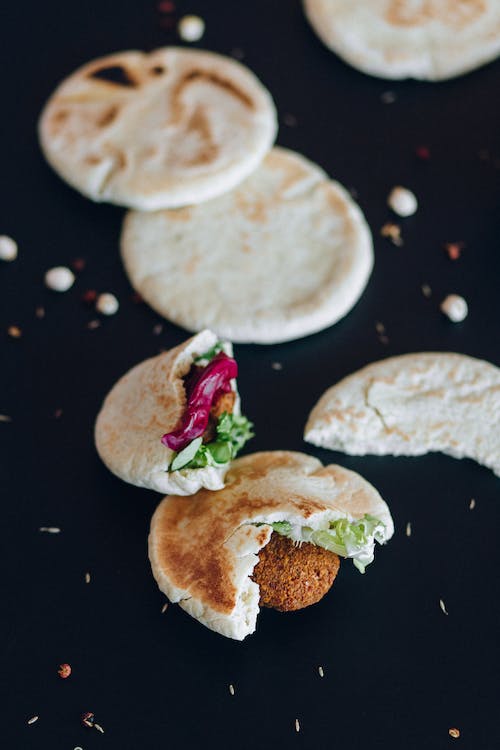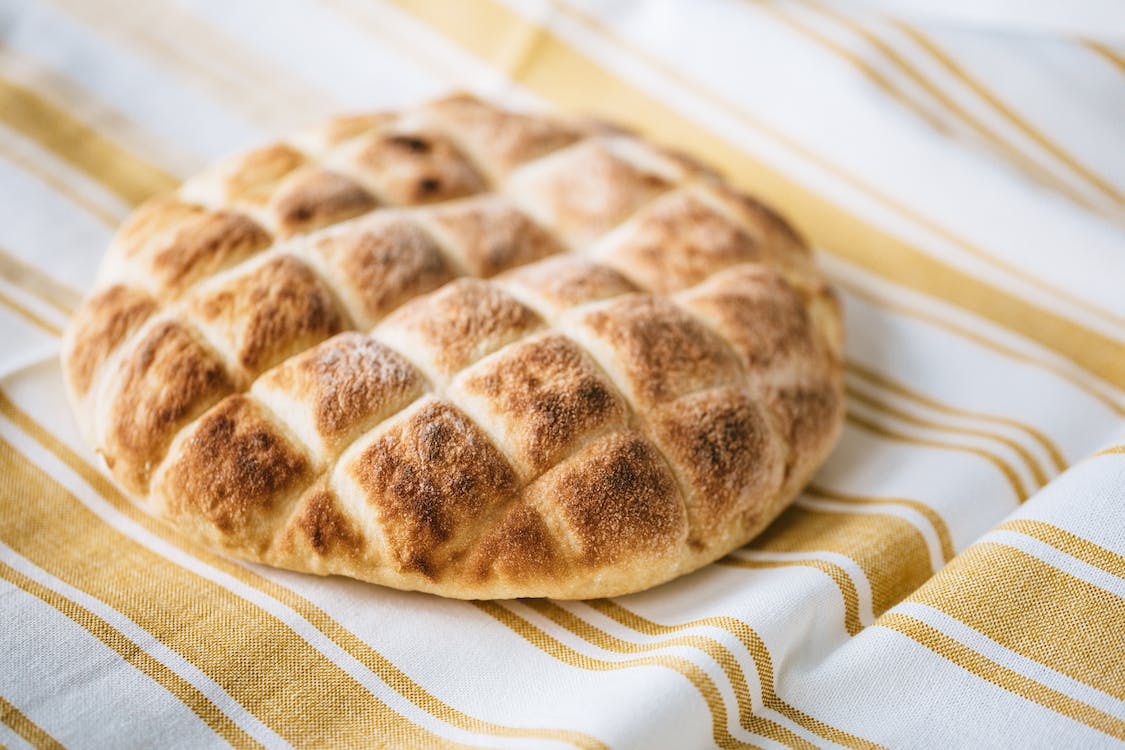Pita bread makes a quick and tasty snack for humans. With its mild flavor and soft texture when toasted or warmed, it’s easy to see why pita appeals to hungry pet parents wondering if they can toss their dog a piece, too.
But are all types of pita bread healthy and safe if your pup begs for a bite? Can you feel good sharing part of your chicken shawarma wrap stuffed in this grab-and-go flatbread?
Let’s explore the pita details every dog owner should know first before grabbing a slice for their hungry canine companion. Because while technically dogs can eat certain kinds of pita, there are definite risks to consider as well regarding the ingredients and preparation methods.

The Safety of Pita Bread for Dogs
Pita’s canine safety profile contains several gray areas to analyze when determining potential feeding risks:
- Ingredient analysis – What’s actually in that pita? Read labels closely to check for toxic items like garlic/onion powder often used in savory bread seasonings. These ingredients can cause hemolytic anemia when eaten by dogs.
- Allergies – Some grain-based bread doughs contain yeast, corn or wheat which are common dog allergens capable of causing gastrointestinal, skin, or respiratory reactions in sensitive pups. Know your pet’s unique tolerance levels.
- Toxicity – Look for sneaky xylitol hiding in low-sugar or “diabetic friendly” labeled pitas. This sugar alcohol substitute spikes insulin dangerously in dogs. Also avoid onion/garlic/chocolate chip pitas and flavor combo risks.
- Choking hazards –If not sufficiently chewed into tiny pieces, pita’s doughy texture poses a choking risk or potentially fatal intestinal blockage. This is especially true for greedy eaters. Pitas can expand rapidly absorbing fluids, so soggy pieces represent an even greater choking or obstruction emergency threat internally.
- Nutritional value – While bland breads like white flour pita provide carbohydrate energy, they lack meaningful nutrition like proteins, healthy fats, vitamins or minerals. So pitas wouldn’t optimize complete diet needs long-term.
Safest bets rotate around identifying allergen-free, toxin-free plain pitas without weird flavor mix-ins. Check labels diligently to provide pieces small enough to minimize mechanical choking risks as well. Even then, unhealthy responses can happen, so know your pup’s unique sensitivities and default to dog treats whenever possible.

Pita Dough Safety
If you bake pita bread from scratch at home, take similar allergen precautions with dough ingredients avoiding wheat/corn/yeast for sensitive dogs.
Uncooked dough made with yeast should be considered unsafe for dogs to eat prior to full baking due to risks of:
- Alcohol toxicity – Fermenting yeast produces ethanol alcohol that can cause vomiting, diarrhea, coordination issues and even liver damage or death depending on the amount of uncooked dough consumed. Just 30g of raw yeasty dough per kg of dog body weight can have toxic effects. So a 50 lb dog would only need to eat about 1 1⁄2 raw pita bread’s worth of dough to potentially make them gravely ill.
- Obstruction/choking – Sticky non-integrated dough expands in the warm, moist environment inside a dog’s digestive tract and can create suffocating blockages or require emergency surgery if large wads get trapped internally behind the stomach.
- Indigestion – Dogs lack the proper enzymes to break down dough constituents before baking. This can lead to severe abdominal pain, bloating, vomiting and diarrhea.
Cooked, well- integrated pita dough becomes safer lowering risks of rising/obstructing internally or retaining much fermentable alcohol content from yeast. But the base ingredient allergy and nutritional concerns would still apply for dogs prone to grains or seeking balanced diet nourishment long-term from people foods.
Quick Pita Bread Feeding Guide
- Seek veterinary-approved brands ensured safe for canine consumption based on your dog’s unique health profile
- Select plain options without onion, garlic or other dangerous flavor additions
- Avoid doughs with corn, wheat or other grains your particular pup reacts poorly digesting
- Prevent choking by shredding pita into tiny pieces and monitoring gobble speeds
- Choose whole grain varieties over white flour pitas when possible for better nutrition
- Rinse/drain or pat dry excess oils if giving pitas straight from oily appetizer platters
- Balance treats keeping pitas under 10% of total daily calorie intake to prevent unhealthy weight gain
- Discontinue feeding immediately if you observe any concerning symptoms suggestive of food intolerance
While an occasional piece may satisfy your pup’s cravings to enjoy this human food with you safely, pitas lack complete nutrition to constitute a dietary staple. For everyday health needs, commercial dog foods carefully formulated with vets beat bread!

Healthiest Human Food Alternatives
If your pooch begs at the table, try these healthier people food options instead of pita to show them some love:
- Shredded low-fat cheese
- Scrambled or hard boiled eggs
- Baby carrots
- Lean diced turkey/chicken
- Unsalted popcorn
- Plain yogurt
- Sweet potato fries
- Blueberries or raspberries
Check with your veterinarian about ideal homemade treats suitable for your dog’s unique needs and limitations. While snacks can add interest, they should not substitute balanced commercial diets meeting full canine health requirements.
The Bottom Line
So can dogs have pita bread? In moderation, plain pita meeting individual allergy/sensitivity guidelines can be safely fed pending diligent monitoring. But uncontrolled gobbling or overindulgence risks serious health consequences for pups. Safer people food options exist providing tastier nutrition without the breadth of precautions breads require reading labels for toxicity avoidance, choking prevention, and individually tailored diet tolerances. Evaluate your own dog’s sample experiences cautiously supervising initial introductions if you determine occasional pita sharing aligns with yourCareful pet parenting can make the difference helping these tempting human foods become soul-satisfyingbonding treats not emergency threats.
Frequently Asked Questions
Q: Can diabetic dogs have pita bread?
A: No. The carbohydrates and starches in pita bread cause blood sugar spikes that can be dangerous for diabetics. Stick with low glycemic treats formulated for diabetic dogs’ needs.
Q: Is pita bread okay for puppies?
A: No. The choking hazard is too great for puppies and small breed dogs. The doughy texture poses a high risk of obstruction internally for unseasoned chewers. Wait until your puppy matures over 12 months old before trying tiny shredded pieces if any pita at all.
Q: Can I stuff prescription pills inside a pita piece to give my dog their medication?
A: No. Dogs may eat around the pills or fail to fully chew/swallow their medication as needed if it’s hidden. Only place tablets directly into your dog’s mouth or use pill pockets/syringes to guarantee dosage compliance.
Q: Is whole wheat pita bread healthier than white pita bread for dogs?
A: Yes, whole grains provide more balanced nutritional value. But wheat-based doughs also contain more potential allergens than white flour. Assess your own dog’s tolerances best determining which type of pita suits their needs, if any should be fed at all.
Q: Can I give my dog pita more often if I also ensure they eat dog food?
A: Not advised. Even if combined with kibble, too much pita raises long-term obstruction, toxicity, and malnutrition risks over time. Reserve pita sharing only for very sporadic special treat occasions, not routine snacking.


